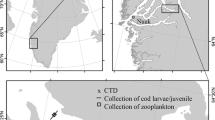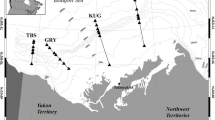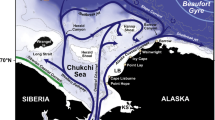Abstract
The influence of environmental variables and habitat on growth and survival of juvenile gadoid species in the Atlantic has been clearly demonstrated; conversely, in the North Pacific little is known about the habitat and ecology of juvenile Pacific cod (Gadus macrocephalus Tilesius). The hypothesis that density of young-of-the-year (YOY) Pacific cod in nearshore habitats is predicted by shallow depth and the presence of eelgrass and macroalgae was tested in a variety of nearshore habitats adjacent to commercial fishing grounds near Kodiak Island, AK. From 10 to 22 August 2002, a beach seine and small-meshed beam trawl were used to capture YOY Pacific cod (n = 254) ranging from 42 to 110 mm fork length. Depth, water temperature, salinity, sediment grain size, and percent cover by emergent structure (i.e. tube-dwelling polychaetes, sea cucumber mounds, macroalgae) were measured prior to fishing. Density of YOY Pacific cod was highest in areas of moderate depth (15–20 m) and positively and linearly related to percent cover by sea cucumber mounds and to salinity. No previous studies have documented fish utilizing sea cucumber mounds as habitat. Furthermore, eelgrass and macroalgae were inconsequential to cod distribution. Diets consisted mainly of small calanoid copepods, mysids, and gammarid amphipods and were significantly related to cod length and depth. This work provides important information on previously undocumented factors that affect distribution and feeding of YOY Pacific cod, which ultimately influence growth and survival in this species.





Similar content being viewed by others
References
Abookire AA, Rose CS (2005) Modifications to a plumb staff beam trawl for sampling uneven, complex habitat. Fish Res 71:247–254
Abookire AA, Piatt JF, Robards MD (2000) Nearshore fish distributions in an Alaskan estuary in relation to stratification, temperature and salinity. Estuar Coast Shelf Sci 51:45–59
Abookire AA, Piatt JF, Norcross BL (2001) Juvenile groundfish habitat in Kachemak Bay, Alaska, during late summer. Alaska Fish Res Bull 8:45–56
Blackburn JE, Jackson PB (1982) Seasonal composition and abundance of juvenile and adult marine finfish and crab species in the nearshore zone of Kodiak Island’s eastside during April 1978 through March 1979. Alaska Department of Fish and Game, Final Report 03–5–022–69 Kodiak, Alaska
Chan KS, Kristoffersen AB, Stenseth NC (2003) Bürmann expansion and a test for additivity. Biometrika 90:209–222
Cote D, Ollerhead LMN, Scruton DA, McKinley RS (2003) Microhabitat use of juvenile Atlantic cod in a coastal area of Newfoundland determined by 2D telemetry. Mar Ecol Prog Ser 265:227–234
Cote D, Moulton S, Frampton PCB, Scruton DA, McKinley RS (2004) Habitat use and early winter movements by juvenile Atlantic cod in a coastal area of Newfoundland. J Fish Biol 64:665–679
Dean TA, Haldorson L, Laur DR, Jewett SC, Blanchard A (2000) The distribution of nearshore fishes in kelp and eelgrass communities in Prince William Sound, Alaska: associations with vegetation and physical habitat characteristics. Environ Biol Fishes 57:271–287
Dunn JR, Matarese AC (1987) A review of the early life history of northeast Pacific gadoid fishes. Fish Res 5:163–184
Field JG, Clarke KR, Warwick RM (1982) A practical strategy for analyzing multispecies distribution patterns. Mar Ecol Prog Ser 8:37–52
Folk FL (1980) Petrology of sedimentary rocks. Hemphill Publishing Company, Austin
Forrester CR, Alderdice DF (1966) Effects of salinity and temperature on embryonic development of the Pacific cod (Gadus macrocephalus). J Fish Res Board Can 23:319–340
Fraser S, Gotceitas V, Brown JA (1996) Interactions between age-classes of Atlantic cod and their distribution among bottom substrates. Can J Fish Aquat Sci 53:305–314
Gotceitas V, Brown JA (1993) Substrate selection by juvenile Atlantic cod (Gadus morhua): effects of predation risk. Oecologia 93:31–37
Gotceitas V, Fraser S, Brown JA (1997) Use of eelgrass beds (Zostera marina) by juvenile Atlantic cod (Gadus morhua). Can J Fish Aquat Sci 54:1306–1319
Gregory RS, Anderson JT (1997) Substrate selection and use of protective cover by juvenile Atlantic cod Gadus morhua in inshore waters of Newfoundland. Mar Ecol Prog Ser 146:9–20
Hamilton JA, Konar B (2006) Kelp bed variability and fish population dynamics in Kachemak Bay, Alaska. Fish Bull US (in press)
Hyslop EJ (1980) Stomach contents analysis—a review of methods and their application. J Fish Biol 17:411–429
Johnson SW, Thedinga JF (2005) Fish use and size of eelgrass meadows in southeastern Alaska: a baseline for long-term assessment of biotic change. Northwest Sci 79:141–155
Johnson SW, Neff AD, Thedinga JF (2005) An atlas on the distribution and habitat of common fishes in shallow nearshore waters of Southeastern Alaska. NOAA Tech. Mem. NMFS-AFSC-157
Keats DW, Steele DH, South GR (1987) The role of fleshy macroalgae in the ecology of juvenile cod (Gadus morhua L.) in inshore waters off eastern Newfoundland. Can J Zool 65:49–53
Kruskal JB (1964) Multidimensional scaling by optimizing goodness of fit to a nonmetric hypothesis. Psychometrika 29:1–27
Lambert P (1997) Sea cucumbers of British Columbia, Southeast Alaska and Puget Sound. University of British Columbia Press, Vancouver
Laur D, Haldorson L (1996) Coastal habitat studies: the effect of the Exxon Valdez oil spill on shallow subtidal fishes in Prince William Sound. In: Rice SD, Spies RB, Wolfe DA, Wright BA (eds) American fisheries society symposium 18: proceedings of the Exxon Valdez oil spill symposium. American Fisheries Society, Bethesda Maryland, pp 659–670
Laurel BJ, Gregory RS, Brown JA (2003a) Predator distribution and habitat patch area determine predation rates on age-0 juvenile cod Gadus spp. Mar Ecol Prog Ser 251:245–254
Laurel BJ, Gregory RS, Brown JA (2003b) Settlement and distribution of age-0 juvenile cod, Gadus morhua and G. ogac, following a large-scale habitat manipulation. Mar Ecol Prog Ser 262:241–252
Laurel BJ, Gregory RS, Brown JA, Hancock JK, Schneider DC (2004) Behavioural consequences of density-dependent habitat use in juvenile cod Gadus morhua and G. ogac, the role of movement and aggregation. Mar Ecol Prog Ser 272:257–270
Lindholm JB, Auster PJ, Kaufman LS (1999) Habitat-mediated survivorship of juvenile (0-year) Atlantic cod (Gadus morhua). Mar Ecol Prog Ser 180:247–255
Lomond TM, Schneider DC, Methven DA (1998) Transition from pelagic to benthic prey for age group 0–1 Atlantic cod, Gadus morhua. Fish Bull 96:908–911
Lough RG, Valentine PC, Potter DC, Auditore PJ, Bolz GR, Neilson JD, Perry RP (1989) Ecology and distribution of juvenile cod and haddock in relation to sediment type and bottom currents on eastern Georges Bank. Mar Ecol Prog Ser 56:1–12
Manley BFJ (1991) Randomization and Monte Carlo methods in biology. Chapman and Hall, New York
Mueter FJ, Norcross BL (1999) Linking community structure of small demersal fishes around Kodiak Island, Alaska, to environmental variables. Mar Ecol Prog Ser 190:37–51
Murphy ML, Johnson SW, Csepp DJ (2000) A comparison of fish assemblages in eelgrass and adjacent subtidal habitats near Craig, Alaska. Alaska Fish Res Bull 7:11–21
Rosenthal RJ (1983) Shallow water fish assemblages in the northeastern Gulf of Alaska: habitat evaluation, species composition, abundance, spatial distribution and trophic interaction. In: Environmental assessment of the Alaskan continental shelf. Final reports of principal investigators, Vol. 17, biological studies. National Oceanic and Atmospheric Administration/National Ocean Service, Office of Oceanography and Marine Services, Anchorage, Alaska, pp 451–540
Rovnina OA, Klovach NV, Glubokov AI, Selyutin AP (1997) On the biology of Pacific cod Gadus macrocephalus in the eastern part of the Sea of Okhotsk. J Ichthyol 37:21–26
Rugen WC, Matarese AC (1988) Spatial and temporal distribution and relative abundance of Pacific cod (Gadus macrocephalus) larvae in the western Gulf of Alaska. Northwest and Alaska Fisheries Center Processed Report 88–18, National Marine Fisheries Service, Seattle, Washington
SAS Institute Inc (2004) SAS/STAT 9.1 User’s Guide. SAS Institute Inc., Cary, North Carolina
Shimada AM, Kimura DK (1994) Seasonal movements of Pacific cod, Gadus macrocephalus, in the eastern Bering Sea and adjacent waters based on tag-recapture data. Fish Bull US 92:800–816
Smith GB, Walters GE, Raymore PA Jr., Hirschberger WA (1984) Studies of the distribution and abundance of juvenile groundfish in the northwestern Gulf of Alaska, 1980–1982: Part I, Three-year comparisons. NOAA Tech. Mem. NMFS- F/NWC-59
Spencer ML, Stoner AW, Ryer CH, Munk JE (2005) A towed camera sled for estimating abundance of juvenile flatfishes and habitat characteristics: comparison with beam trawls and divers. Estuar Coast Shelf Sci 64:497–503
Stepanenko MA (1995) Distribution, behavior, and abundance of Pacific cod, Gadus macrocephalus, in the Bering Sea. J Ichthyol 35:18–27
Stevens BG (2003) Settlement, substratum preference, and survival of red king crab Paralithodes camtschaticus (Tilesius, 1815) glaucothoe on natural substrata in the laboratory. J Exp Mar Biol Ecol 283:63–78
Takatsu T, Nakatani T, Mutoh T, Takahashi T (1995) Feeding habits of Pacific cod larvae and juveniles in Mutsu Bay, Japan. Fish Sci 61:415–422
Tupper M, Boutilier RG (1995) Effects of habitat on settlement, growth, and postsettlement survival of Atlantic cod (Gadus morhua). Can J Fish Aquat Sci 52:1834–1841
Venables WN, Ripley BD (2002) Modern applied statistics with S, 4th Edition. Springer, New York
Yamamoto T (1939) Effects of water temperature on the rate of embryonal development of eggs of the Korean codfish, Gadus macrocephalus Tilesius (translated from Japanese by Fish Res Board Can Transl Ser 554, 1965). Bot Zool Tokyo 7:1377–1383
Yamanouchi T (1926) Some preliminary notes on the behaviour of the holothurian, Caudina chilensis (J. Muller). Sci Rep Tohoku Imp Univ 2:85–91
Acknowledgments
We thank Captain Mary Jacobs, Billy Smith, and the crew of the M/V Renaissance for their hard work during the cruise. We especially thank Sara Persselin for her outstanding assistance with fish collections. We also thank Scott McEntire for conceptualizing and assembling the underwater camera system and Craig Rose for designing the beam trawl modifications. We thank Philip Lambert and Eric Munk for identification of the rat tail sea cucumber and Allan Stoner for family identification of the tube-dwelling polychaetes. We appreciate the generous net and electronic equipment loans from Scott McEntire, Dan Nichol, Brenda Norcross, Brad Stevens, Allan Stoner, and Dan Urban. Sediment samples were processed by Mark Blakeslee. We thank Mike Litzow for assistance with randomization-test analysis and David Cassell for the SAS randomization-test program. The algorithm used for NMDS analysis was written by Brian Ripley and posted on the website StatLib by the Carnegie Mellon University. We thank Chris Rooper, David Somerton, Mark Wilkins, and Matt Wilson for critiquing the manuscript. This research is contribution FOCI-0566 to NOAA’s Fisheries-Oceanography Coordinated Investigations. Funds for this project were provided by the Resource Assessment and Conservation Engineering (RACE) Division of the Alaska Fisheries Science Center.
Author information
Authors and Affiliations
Corresponding author
Additional information
Communicated by J.P. Grassle, New Brunswick
Rights and permissions
About this article
Cite this article
Abookire, A.A., Duffy-Anderson, J.T. & Jump, C.M. Habitat associations and diet of young-of-the-year Pacific cod (Gadus macrocephalus) near Kodiak, Alaska. Mar Biol 150, 713–726 (2007). https://doi.org/10.1007/s00227-006-0391-4
Received:
Accepted:
Published:
Issue Date:
DOI: https://doi.org/10.1007/s00227-006-0391-4




